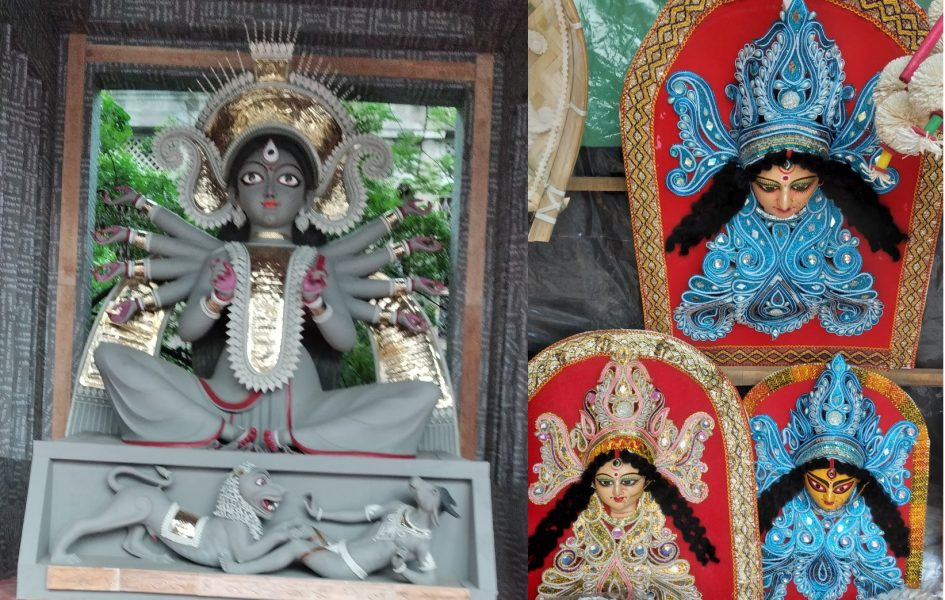
At Kolkata’s Kumartuli, Durga is non-conformist, unconventional
The potters, artists, sculptors, painters and craftsmen have outclassed their own brilliant inheritance by making an unconventional and non-conformist Durga this year

This Durga is different. She is a young, beautiful girl, almost like a teenager in eternal innocence, serene, composed and calm, her large beautiful eyes hiding wonder and curiosity. She is like that moment concealed in all the four seasons in Bengal, with its sudden, nuanced stillness, when a thunderstorm, touched by the salt of the sea wind, with its theatrical lightning, thunder and sound, and a fierce rain, must eventually arrive in a dense, green landscape, soaking, drenching and healing the world.
She is also a young Durga, who has arrived after a deadly, killer pandemic, finally overcoming protracted sorrow, anxiety and depression. Certainly, she has arrived with amazement and optimism, looking for a new life, a new beginning.
As Bengal waits for the rain in this festive season, predicted by the inevitable cyclical pressures in the Bay of Bengal, the Kumartuli Sarbojanin Durgautsav Committee, celebrating 92 years of its existence, has created a goddess which is unprecedented, unconventional and non-conformist — a classical work of art, a masterpiece.
Also read: Durga Puja mantras: Campaign seeks to replace Sanskrit with Bangla
“They should not immerse her in the Ganga on Vijayadashami’s ‘Bisharjan’,” said a woman student. “They should preserve her in an art gallery or a museum – so that this work of genius can be seen by others in the years to come.”
‘Art installation’ in middle of big lane
This Durga is indeed different. She is not a mature woman decked in ornaments and dressed in an exquisite sari, not fair, fierce or fiery, not even ready to assassinate the Mahishashura. Instead, she seems a darkish, village girl, still so innocent like a mountain stream, as if meditating with her eyes open. She could also be a Santhal girl, an Adivasi, as if she has been suddenly discovered from inside a primordial habitat, like a miracle, untouched and pristine, her skin still hiding the twilight zones of the forest darkness. Even in her serenity, she expresses and hides, at once, an expanse of incipient, unruly playfulness and deep, youthful beauty.
At the famous Kumartuli in old Kolkata, in this Durga Puja, the potters, artists, sculptors, painters and craftsmen, have truly outclassed their own brilliant and incredible inheritance, when it comes to the making of the goddess this year.
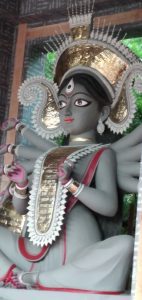
There is no pandal here. It is like a gigantic ‘art installation’ in the middle of a big lane where you can pause for a while, take a long breath, and inhale and absorb the epical beauty of this sublime work of art. Surprisingly, there is no Mahishasur with the goddess here, nor is there a lion out to ravage the asura, accompanying her. She is looking beyond the horizon, almost detached from the world; there is a tiny sculpture much below her, detached from the main installation, so small that you can miss it – of a lion and a creature with the head of a buffalo (moish, in Bengali), a little Mahishasur. There is no violence happening here.
Also read: Special menu for inmates in Kolkata’s prison during Durga Puja
The gods and goddesses, her companions – Lakshmi, Kartik, Ganesha, Saraswati – are in their separate compartments, solitary and dignified. All the pets of the gods and goddesses too are separated — they seem to be playing with each other. This is a completely different interpretation of the goddess and her companions and pets, undoubtedly.
Tribute to all great artistes
Besides, the Pals, who are the celebrated community of legendary potters, artistes and sculptors over the many decades, have dedicated this brilliant ‘art installation’ to the memory of the hundreds of artistes who have made the idols at Kumartuli over the years. Their names are carved in wood, stretching across horizontally next to the wall, in multiple flag-like banners flying in the sky, on huge banners flanking the walls of the streets, and in the backdrop of the goddess. The names go on and on, as a tribute to all the great artists who have celebrated their hard labour, sweat and genius in this extended gallery where brilliant works of art flourishes in every bylane: Patit Pawan Pal, Haru Pal, Kamal Kirshna Pal, Ajit Pain, Swapan Kumar Pal, Babul Pal, Tapan Pal, Chand Pal, Sanatan Pal, Harihar Pal, etc, — the names, in different font and styles, are carved all over.
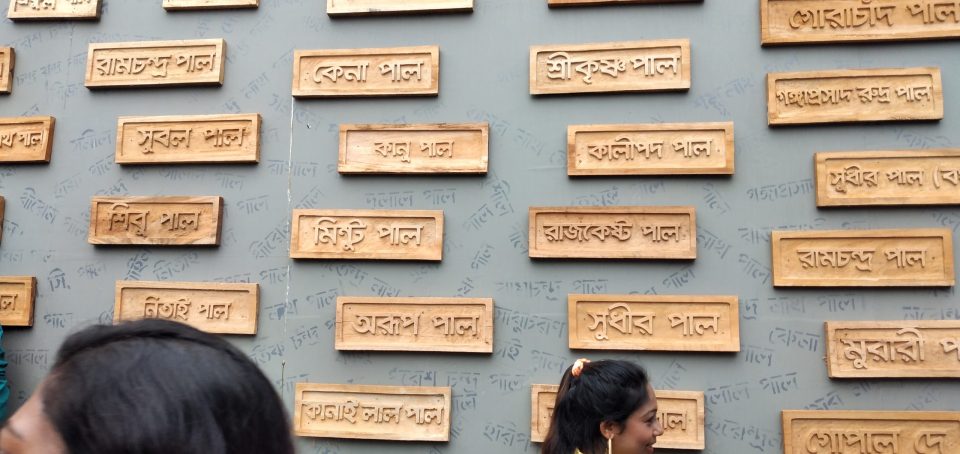
“Durga Puja would be incomplete without idol-makers and this year we have decided to salute these unsung heroes,” said Debashish Bhattacharya of Kumartuli Sarbojanin Durgotsav Committee, to the media. Other organisers said every artiste who had contributed over the years in the making of the goddess, from collecting the alluvial mud from the shores of the Ganga, getting the raw material like straw, bamboo, clay, paint, etc, to the making of the goddess, has been given the pride of place during this Durga Puja.
Also read: Mahatma Gandhi look-alike as Asura in Kolkata puja pandal stokes controversy
On Saturday (October 1), it is Shashti, the day the curtains are lifted with that vintage Hemant Kumar song floating in the air – Jaago Durga – after she arrives for a short, fleeting and heady visit to earth. On this day and thereafter, all roads are leading to Kumartuli, earlier called Coomartolly, the potters’ quarters, in that ancient landmark called Sutanati, close to the river Ganga, when Calcutta was not even born in the imagination of the British. This is perhaps the earliest village in the ‘Mahanagar’ with its magnificent, archaic and palatial buildings with innumerable windows and exquisite doors in the inner lanes, now in ruins, reminiscent of the life and times of the hedonistic zamindars and elite of the past.
Impact of lockdown
In the backdrop of shehnai playing across the streets, with thousands of people in brand new clothes, and women wearing saris in a kaleidoscope of textures, fabrics and colours thronging the Kumartuli lanes, it is a day of rest for the sculptors. The idols have long gone all over Bengal and the rest of the country, and all is quiet in the potters’ quarters. Except for the incomplete idols of Kali, Lakshmi and Narayan, as their day of puja arrives around Deepawali, when Kali is worshipped with the difficult mantras of ‘Chandi Paath’, and Lakshmi’s dainty little feet with rice powder is drawn outside and inside the doors, to welcome her into the house.
Ranjit Das, owner of an ornament shop to beautify the goddesses, is perhaps one of the few still around in Kumartuli. “The last two years have been so bad that we thought we will never recover. Thanks to Ma Durga, this year has been wonderful for all the sculptors and artistes, as the festival is back with great fanfare. Even I have made profits.”
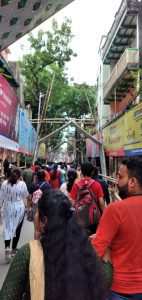
During the pandemic/lockdown, this reporter visited the area several times. It would be desolate and sad, with a few committed artistes still working on smaller idols, because the bigger idols were not wanted anymore. Young graphic artist Khsonish Pal, from a family of artists and sculptors, was holding the fort. His father was Haru Pal and grandfather, Bhuvan Mohan Pal, both legendary artistes — their nameplates are still displayed with pride outside his humble studio in a tent-like structure with a little table fan, where he works, eats and sleeps.
Also read: 3 killed, 64 injured as fire breaks out in Durga Puja pandal in UP
A graduate in philosophy, and originally from Krishnanagar, Mohua Moitra’s constituency, in January 2020, just before the West Bengal Assembly elections, he was digging in against all odds. He was then making a small idol of ‘Annapurna’, whose puja follows the harvest season festivities – Poila Boishakh – which is also celebrated as Shubho Noboborsho (auspicious new year) in Bengal.

The pandemic had taken the spirit away from his art. But he was optimistic: “I have the small goddesses. She gives me creative joy. The tide will turn, I am sure,” he had then said.
The tide has indeed turned this year.
Secular, pluralist celebration
Across Kolkata, it is like an endless procession of people soaked in the spirit of festivity, pandal-hopping, as if moving from one gallery and art installation to another. In that sense, the city is virtually transformed into a relentless spectacle of art galleries with the goddess showcased with myriad forms of creative brilliance. No wonder, locals here are proud that UNESCO has proclaimed the Durga Puja in Kolkata as a World Heritage Art Site.

The contemporary too is reflected in the many pujas. During the lockdown, the suffering of the migrant workers on the scorching summer highways, running away from big cities, was sensitively highlighted in the Barisha Club in South Kolkata – Durga became a migrant woman worker, holding a child, looking back with certain stoic defiance and dignity, her red sindoor smeared. During the 100 years celebration of Satyajit Ray’s birth anniversary, there were pandals designed like a ‘Ray Museum’ – with his films, books, sketches, novels, and detective fiction as A big draw. So much so, you would find his characters along with Durga on the main stage.
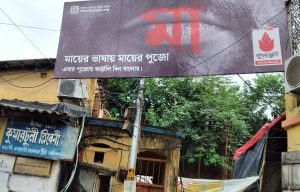
Besides, the delicacies and food are a kind of secular and pluralist celebration. In East Delhi, you will see seasoned Muslim connoisseurs from Jama Masjid making various kinds of biryanis on the spot inside the puja pandals, close to the idols and the chantings. In some ‘homely’ pandals like in ‘Purbasha’ in Mayur Vihar, ‘Mashimas’ (aunts) would make ‘maida luchi’ (puri) and kosha (dry) mutton and chicken, a special delicacy, while women would dance during the evening ‘aarti’ holding the flame. Plus, there will be the usual: Egg Devil, Mutton/Fish cutlets, Vegetable Chops, Mocha Chops (made with banana flowers), and, of course, roshogollas and sandesh.
Also read: Planning a 5-day Kolkata Durga Puja trip? We have a travel guide
That is why historian Tapati Guha-Thakurta in Kolkata asserts that the Durga puja “has ceased to be purely religious in its urban form a very long time ago”. Indeed, it has become a magnificent creative expression of aesthetic and cultural brilliance, in a spirit of collective and shared bonhomie and joy. This puja, besides, is especially special and liberating. This is because Durga has arrived after two years of solitude — and forced isolation, suffering and despair.
(Amit Sengupta is an independent journalist and columnist)


